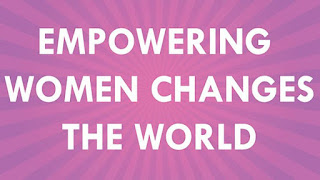- Get link
- X
- Other Apps
- Get link
- X
- Other Apps
Feminism
and Three-Waves
Background
Women's
liberation is a development that promotes sex equality for women and works to
protect their rights and interests, much like political and sociological
theories and modes of thought that are concerned with issues of sex
comparison.
Work and Women
Following
the successful employment of many women in the military or in professions
previously reserved for men during World War II, Rosie the Riveter became a
symbol of the feminist movement. Following the advancement of social rights,
women pushed for a more significant commitment to a work environment, with fair
wages at the top of their requirements. The Equal Pay Act of 1963 was
one of the main efforts to solve this still crucial issue.
The rights
of women have altered prevailing viewpoints in a variety of domains within
Western civilization, from culture to law. Women's activism now centres on women's legitimate rights (privileges of agreement, property rights, casting a ballot). For the protection of women and young girls from domestic
abuse, rape, and assault; for rights in the workplace, such as maternity leave
and reasonable compensation; and against sexism. For early termination
opportunities, conceptive rights (including access to contraceptives and quality
pre-birth care).
For a large part of their history, white working-class women from Western Europe and North America have been at the forefront of most feminist activist movements and beliefs. According to Simone de Beauvoir, Christine de Pizan's Epitre au Dieu d'Amour, written in the fifteenth century, was "the first instance where we witness a lady picking up her pen with regards to her sex."
Waves of Feminism
First Wave
The period
of 1918 saw the passage of the Representation of the People Act, which gave
women over 30 who owned homes the right to vote. This was made available to all
women above the age of twenty-one in 1928. Lucy Stone, Elizabeth Cady Stanton,
and Susan B. Anthony were leaders of the movement in the US. Anthony, who
supported the annulment of bondage before supporting women's testimony, was inspired entirely by Quaker's philosophy. The primary influx of women's rights
in the United States was dynamic and included women from a variety of
backgrounds.
The phrase "first wave" was coined in retrospect after the term "second wave" women's liberation was used to describe a younger women's activist development that emphasised addressing social and social inequality as it did political inequalities.
Second Wave
The proverb
"The Personal is Political" was introduced by Ditty Hanisch, an
extreme women's rights activist and inventor, and it became associated with the
following wave. Second-wave women's activists, who gave women the ability to
regard aspects of their own lives as profoundly politicized and challenging
misogynist power systems, saw women's social and political differences as
inextricably linked.
Additionally,
during this time Fatema Mernissi, a well-known Islamic feminist proposed her first book, Beyond the Veil: 1975. She examined the
feminist viewpoint in relation to Islam as well as the place of women in the
Islamic community, particularly in light of Islamic teachings.
Third Wave
A key
component of the third wave's philosophy revolves around a post-structuralist
understanding of sex and sexuality. Third-wave women's rights activists are
renowned for focusing on "miniature governmental concerns" and
putting the second-wave model of women's rights to the test of what is
consistently unhelpful for women. The third wave's roots date back to the
middle of the 1980s. Gloria Anzaldua, Chime Snares, Chela Sandoval, Cherrie
Moraga, Audre Lorde, Maxine Hong Kingston, and many other black women's
activists who emerged in the next wave made an effort to carve out space within
the feminist concept for racial subjectivism.
People who recognize that there are significant differences between the sexes—such as therapist Carol Gilligan—as well as those who believe that these differences are not inborn and that sexual orientation is socially shaped are both included in third-wave women's liberation talks.
Feminism and Modern World
Instead of encouraging women to become
contented people who benefit future generations rather than seeking retribution
for the mistreatment of previous generations, modern feminism encourages women
to constantly fight against the allegedly oppressive patriarchy that has haunted
them since the beginning of time.
Women have been working to change
male-dominated industries since the turn of the century, particularly the
entertainment sector. One would assume that brand-new feminist movies are
dominating the market.
People's dissatisfaction with the woke
feminist worldview is demonstrated by the modern feminist remarks in
traditional American films. Taking movie ratings as an example. The remarks of
the first "Wonder Woman 1984 (2022)," has a 5.4 out of 10 rating on
Google. A staggering 5.7 stars have been awarded to "Mulan (2020),"
whereas the iconic "Charlie's Angels" adaptation has received 4.9
stars out of 10. Despite the fact that the originals were American
blockbusters, none of these movies did well.
Conclusion
Since its inception in the late nineteenth
century, feminism has seen significant development. The main objective of
first-wave feminism was to acknowledge women as people rather than as objects
of property. Third-wave feminism represented the value of uniqueness and
autonomy while second-wave feminism questioned the place of women in society.
Although feminism was intended to support
and empower women, it has given today's young women a toxic mentality. In
addition to teaching women to despise males, it demonstrates that
they don't need to pay attention to criticism or advice. Modern feminism has
made women egoistic and entitled, which are traits they despise in males.
Today's women are unaware that a guy does
not have to lower himself in order for a woman to ascend. Why then do women
continue to undermine men? The goal of feminism has always been gender equality
and respect for all people.
For More Articles Check This...









Comments
Post a Comment